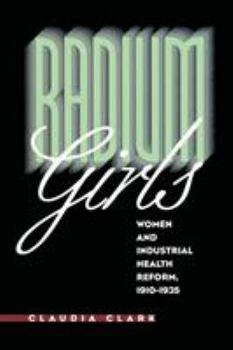Radium Girls: Women and Industrial Health Reform, 1910-1935
Select Format
Select Condition 
Book Overview
In the early twentieth century, a group of women workers hired to apply luminous paint to watch faces and instrument dials found themselves among the first victims of radium poisoning. Claudia Clark's... This description may be from another edition of this product.
Format:Paperback
Language:English
ISBN:0807846406
ISBN13:9780807846407
Release Date:July 1997
Publisher:University of North Carolina Press
Length:304 Pages
Weight:1.05 lbs.
Dimensions:0.7" x 6.3" x 9.2"
Customer Reviews
2 ratings
Detailed historical examination of radium hazards
Published by Thriftbooks.com User , 26 years ago
"The doctors tell me I will die, but I mustn't. I have too much to live for-- a husband who loves me and two children I adore. They say nothing can save me, nothing but a miracle." Ottawa native Catherine Donohue wrote those words and more from her bed to the Our Lady of Sorrows Roman Catholic Church in Chicago in the mid-1930s. She asked for a novena to bring her a miracle. She had to write the words for she could not speak them. Her teeth and a large portion of her jawbone were gone. Cancer was eating away at her bone marrow. The doomed young mother weighed only 65 pounds. Catherine Donohue was a charter member of the nonexistent organization, "The Society of the Living Dead," so called because members had two things in common: all worked at the Radium Dial Company in Ottawa, Illinois and all eventually suffered an agonizing death from radium radiation poison. More than 30 of these area co-workers (among others in dialpainting plants across the country), each of whom painted a radium-laced solution onto clock faces, watch dials and military equipment so they would glow in the dark, found that the simple habit of licking their brushes into a fine point eventually gave them terminal head and bone cancer. The tragedy, which became a major news story of the 1930s, evolved to a classic text book workplace hazard case that continues to generate controversy and affects city residents in the 1990s. These luminous paint workers and their struggle to have their mysterious symptoms recognized as an industrial disease is told in finely researched detail within the new book, Radium Girls: Women and Industrial Health Reform, 1910-1935 by Central Michigan University historian Claudia Clark. Besides the promise of decent work for decent pay, Clark writes, part of what must have made dial painting an attractive job was working with such a sensational product, glow-in-the-dark paint. Assured that the radium-laced compound was completely safe, even digestible, the young women painted their dress buttons, fingernails, eyelids and even their teeth for fun. When they went home from work, they thrilled their families and friends with glowing clothes, fingers and hair. The book explains that the greatest exposure to radium was in the mouth and jaw area of these women. Dialpainters were instructed in the technique of lippointing to perform their finely detailed work. Mixing the dry, luminous paint powder with paste and thinner, the workers drew their small brush to a point with their lips before dipping it in the paint, and then meticulously filled in the numbers or other marks on clockfaces or other equipment before repeating the process. In great minutiae, Clark retraces the steps that these dying dialpainters took to uncover exactly what was killing them in an era where most workers, especially women employees, had very little power. The author explains their frustration as they discovered alarming facts about the danger which were withheld
A "Glowing" Account of Women Struggling for Their Health
Published by Thriftbooks.com User , 26 years ago
This book is fascinating--It is readable, non-technical, and covers an intriguing and little-known subject. It describes an episode of women's activism on health issues before activism was considered the proper province of women. During and after World War I, hundreds of women, mostly young and unmarried, were employed to paint the dials of watches with self-illuminating paint containing Radium. Some of the women began to fear for the job's effects on their health, but had great difficulty in getting any action taken. This book describes their efforts to have these hazards corrected, and the problems they had dealing with uncaring factory management, inept government officials, skeptical members of the medical community, and eventually with the courts. It is disturbing, yet fascinating! Highly recommended





